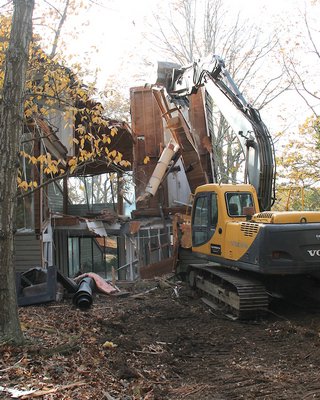
The public has a long-held fascination with demolitions, especially the big ones such as stadiums, hotels and housing projects. They always seem to represent “the end of an era,” because “there’s no stopping progress.”On the nightly news, we bear witness to these events as we watch, with fascination, a sequence of engineered explosions and the total collapse of a structure in a matter of seconds. Always good for ratings, these televised demolition segments are basically a spectator sport.
For architects, however, watching demolitions can create a certain jolt to their raison d’être. The mind races as it conjures up thoughts of the design, its development, the thousands of man-hours used to produce a voluminous set of construction drawings, as well as all of the work related to the administration of the project and its construction.
It’s hard not to have a sinking feeling, especially when the remains of a building, which once represented an achievement for its architect, are carted off to a landfill.
As one who has seen more demolitions of important residences than I ever thought imaginable, it still comes as a shock, particularly when its architect is a friend, colleague or legendary figure whose work I admire.
Last week, when I read about the demolition in this paper of the Chico Hamilton house (1973) on Waterhole Road in East Hampton, it came as something of a surprise to learn that the house was not considered to be historically significant. Mr. Hamilton’s home was one of the early small houses in the Hamptons designed by architect Norman Jaffe (1932-1993).
Mr. Jaffe loved jazz and first met Mr. Hamilton at the Hague Club in Los Angeles in the early 1960s, when he was the drummer with the Jerry Mulligan Quartet. They had a mutual friend, Harold Becker, and Mr. Hamilton, who loved the Wainscott house that Mr. Jaffe designed for Becker, commissioned Mr. Jaffe to design a house for him.
Mr. Hamilton’s house was inspired by Richard Meier’s Saltzman House in East Hampton. The site was narrow and wooded, “moody and mysterious” to Mr. Jaffe. So he had to find a way to bring “craved” light into the building from above.
He accomplished this by creating a series of vertical, interconnected open spaces allowing for light to cascade down several stories. The whole effect was one of celestial light filtering through the spaces.
Architects often develop themes that define their work, and Mr. Jaffe played with light from above for his entire career. From the Hamilton house to his own house in Bridgehampton to the Jewish Center of Hamptons in East Hampton, Norman Jaffe incorporated his theme of light as a form of expression by connecting the occupant to the natural world, as well as using it to highlight the textures and inherent features of materials like stone and wood.
The Chico Hamilton house demolition is very disconcerting. The 0.81-acre property, sold to East Hampton Town for $900,000 by the Hamilton Family Trust, will be used for open space preservation. The money for the purchase came from the Community Preservation Fund, which also contains little-used provisions for historic preservation.
Whether or not this house should have been saved is a subject for debate. However, the continued demise of houses from the recent past, not yet eligible for landmark status, will leave an unforgivable gap in our cultural history.
It is, nonetheless, quite ironic that the CPF should be used to demolish the home of a person of importance and the work of a nationally renowned residential architect, also one of the Hamptons’ most important architects.
Scott Wilson, the director of Land Acquisition in East Hampton, said in an email Monday that there was no indication from the broker or during the public hearing process that the parcel was historically significant. “Also, regardless of the importance of the owner, our practice requires structures to be 50 years or older to qualify for a historic designation,” he wrote.
Mr. Wilson explained that the town has been acquiring a number of properties on Hog Creek, “as that particular water body is in distress.” He said removing structures and lawn will mean less runoff and better filtration for the creek.